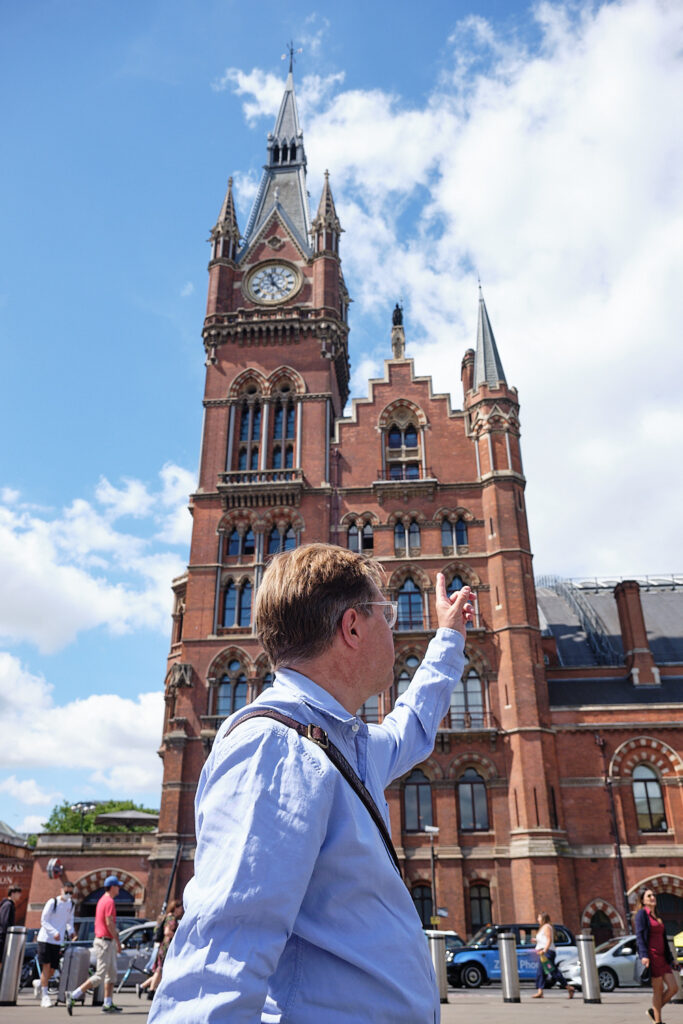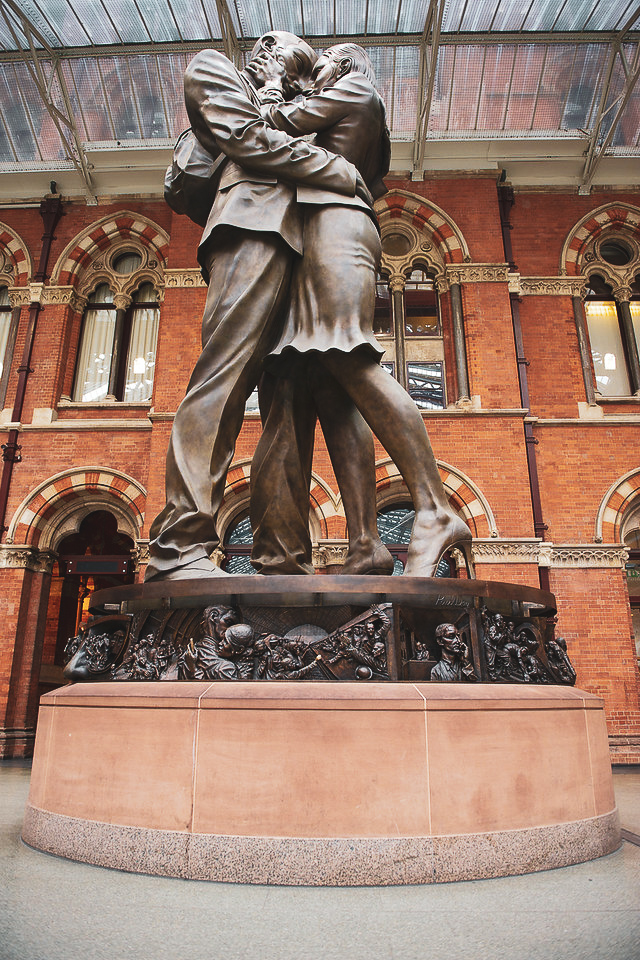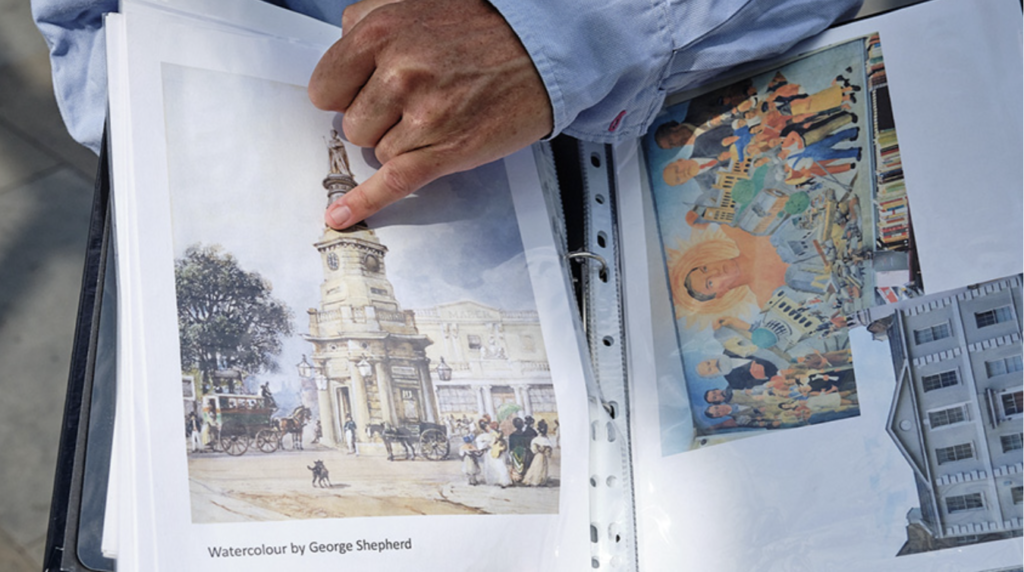
Exploring the Poetry of London’s Streets: A Journey with Ben from King’s Cross to Clerkenwell
- 12 March 2024
- by
There is a certain poetry to be found in walking city streets…
I take visitors to London on a walking tour that starts at St. Pancras International train station, with Unseen Tours: we focus on the many layers of this complex city, the juxtaposition of old and new, and surely London’s greatest speciality, the comings-together of unlikely subjects – the history of technology, the way the canals joined up here to the railways, and, more recently still, the internet and fibre-optic cable; the flow of materials, ‘stuff’, shifting in time to include the movement of people, and finally (one hopes) ideas: texts, sounds and images. The new Google headquarters will snake unobtrusively right alongside the train route from England up to Scotland. I am myself English, Irish and Scottish: I hunger for connection. As we walk, there is the poetry of our footsteps beating out a rhythm: on occasion even a chunk of literal poetry, for example, the odd line by Betjeman inscribed on a large round discs on the very floor of the station – “poetry underfoot”.

I recite one of these out loud on my tour. The spiritual teacher Thich Nhat Hanh suggested that walking can become a kind of healing, if we have the right attitude. It is though we are caressing Mother Earth with our feet, that mother who is always there for us, who gives us life, and to whom we will return, in spite of our repeated abuses of her, mining, digging out material, and pouring poison and fire into and on to her. My walk Includes the pedestrian-only paving stones that connects Cumberland Gardens to Wharton Street, which must surely be the most silent stretches of pavement in our capital city. I often propose to my guest-tourists, that we all cease talking just for five minutes, to enjoy pacing down this walkway and tasting the rare quiet. It is incredible. Quite often the only sound you can hear are literally the planes overhead, or a dog barking, nothing more.
In summer, pale green hops leap joyfully over the black painted railings. But to get it you have to pace slowly, with respect and patience…

I always begin my tour at Paul Day’s statue “the Lovers”. The huge couple embracing romantically on the plinth, I always knew instinctively, had surely come from different countries: indeed, it turns out I was right – that the models were the artist and his wife, he a Brit, and she from France. In these dark times, we surely need international hugs. Down below, where a relief frieze in bronze depicts a series of vignettes, is included a scene with a painful poignancy today: soldiers are arriving back from Europe, blinded by mustard gas, from the First World War. New soldiers are departing on the trains. A boy is frantically waving to his relative who waves back dressed in military gear on a train: perhaps their hands will never meet again. The boy’s hand, only marginally larger than my thumbnail, is popular and gleams gold – polished by the finger rubbing of a thousand tourists (only the doggie’s nose around the corner is shinier). And yet in the same scene, in an intriguing visual anachronism, right behind the squad of soldiers, the artist has placed a sleek modern international train, quite possibly the Eurostar, gliding out behind the troops.
Is the sculptor expressing a kind of metaphor, as though to hint that perhaps if only we could spend more time travelling by train across borders, might there be less need to loathe and fear the Other, and less tendency towards conflict and war?
Another kind of engineering which serves as a metaphor for that which co-joins us is, of course, the bridge, which serves as a vision of our interconnectivity and the alternatives to war. Many of us were much moved by the rebuilding of the “Stari Most” bridge, shelled in the Croat-Bosniak War. Originally built by Suleiman the magnificent, it was eventually reconstructed all over again in an astonishing collaboration of Hungarian divers, the UN, the World Bank, Italy and Turkey, and the Aga Khan Trust, among others.
It is intriguing that in his recent poem, “The Void”, the poet Ben Okri describes a bridge which can be walked over by foot, not traversed unthinkingly in vehicles. Also, he presents us not with an idealised, imagined and utopian construction, but presents it (in a colloquial style) as something he has learned about by talking to the builder of the bridge, described as
“the structure that brings two warring elements together.”
The peculiar feature of this bridge is that in the middle is an invisible gap or space, left there, presumably to be stepped over, to serve as a reminder of the very absence of unity and agreement:
"Neither half meet. The gap is for thermal expansion of the tough material."
It is said that this is the gap that history falls through. Somehow, this account of a weird bridge with a space at its very heart, which self-consciously acknowledges this gap (in the way we are encouraged to do during meditation), and un-joinability, feels very contemporary and feasible.

“To walk that bridge is to feel the swaying danger of the wind and the heights the howling drop. No one can walk the bridge without respect, holding on carefully… aware of… the pitiless desert all around.”
The poem itself is constructed with enjambement, meaning that to complete each sentence one’s eye is constantly flicking down to the next line, whilst being aware of blank space – the empty portions of the page. The poem being “centre-aligned“ instead of left-aligned, as it were following its spine in the middle of the page, actually resembles on the page a kind of bridge, as seen in an aerial view, from above.
The conclusion of the poem is that:
“We need a new kind of bridge, not one that brings these irreconcilable peoples together, but that reminds them every day into what emptiness they both can fall.”
There is a realistic, tough-materials quality to this description of a bridge, given the “madness” and turmoil we find ourselves in at the current time. Perhaps we truly do need mutual terror as a motivating force, rather than sweetness and light.
– Ben